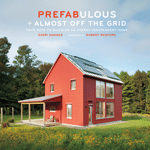Green building can be fun, just ask anyone who preordered the latest edition of popular computer game SimCity, which weaves questions of energy dependence and pollution into the gameplay. Softwalks also thought about making urban spaces more fun when it invented a simple way to turn sidewalk scaffolding into pocket parks. Ranging from high-tech tools (in 4-D, no less) to a book of prefab excellence, our Editor’s Picks are perfect for the jobsite and the coffee table. See all the picks below.
1. Walkable Photovoltaic Roofing
Don’t walk on just any solar panel; make sure it’s a system from Onyx Solar. The global photovoltaics company is currently developing a solar-generating product that replaces typical roofing material. Composed of elevated ceramic roof tiles laminated with photovoltaic glass, this would give architects a new toolbox for solar-energy solutions without sacrificing walkable surface area.

These photovoltaic panels don’t need mounted; they’re integrated into the roof surface and can be walked on.
2. The New SimCity
The original SimCity debuted in 1989, and aspiring architects and urban planners have long loved designing hypothetical, digital cities. EA Games’ latest version—the first new edition since 2007 and, at the time of press, slated for an early 2013 release—is distinctly of our time and deals with ideas well-known to gb&d readers: the benefits of renewable energy, ways to reduce pollution, and the dangers of depleting our natural resources. Want to share your passion for the environment with your kids? SimCity just made it a little bit easier.

A still from the newest SimCity shows the impact of energy generation, a new aspect to building cities in the game world. Here, coal is the main source of energy, and pollution has become a serious problem.
3. Prefabulous + Almost Off the Grid
Sheri Koones hints at something important in the title of her new book: sustainability is not pass or fail. LEED certifies buildings by degrees; mechanical systems are 30 percent or 50 percent more efficient than their predecessors. And a home doesn’t need to be off the grid to be green. In the latest book in her Prefabulous trilogy, Koones profiles 32 American prefab homes, including The GO Home on the cover, built by G•O Logic. And bonus: Robert Redford pens the foreword.
4. The Crystal
When Siemens wanted to fan the flames of the green movement, it went big. The global engineering and building technologies group conceptualized a crystalline structure at London’s Royal Docks that would house the world’s largest exhibition on urban sustainability. It named the building The Crystal and hired Wilkinson Eyre Architects to design it, and although the glass-clad building is cool enough, what really got our attention was the opening in 2012, which featured a video mapping that was projected directly onto the multifaceted façade by Innovision.
(Click to watch the event! Or go behind the scenes!)

The Crystal, the night of its opening, its facade lit up by video. The new London building houses the largest exhibition on sustainability in the world.
5. 4-Dimensional Augmented Reality
As digital cameras become more and more common on construction sites, Mani Golparvar-Fard, an assistant professor of civil and environmental engineering at Virginia Tech, wants to harness them for a new digital tool called the D4AR. Short for 4-Dimensional Augmented Reality, the technology merges in-construction photos with BIM, allowing remote 4-D access, which is 3-D plus time, to a project’s progress. The tool is being beta-tested by Turner Construction on the new World Trade Center building.

Mani Golparvar-Fard shows off his team’s D4AR software, which will allow builders to use the data of digital cameras to enhance the construction process.
6. Softwalks
Sidewalk sheds are ubiquitous and yet barely noticed. We’ve come to perceive the roofed-over pathways beneath construction scaffolding as purely functional, a utilitarian solution that, though dimly lit and ugly, at least lets us get from point A to point B. Softwalks has a better idea. Using a modular kit of planters, seats, counters, and lighting—all of which attach directly to the scaffolding—the company can transform these uninhabitable spaces into pocket parks, an idea so good it was included in Fast Company’s 2012 Innovation by Design Awards.

A rendering of Softwalks’ imagined pop-up gardens and cafes designed to be modularly built within sidewalk sheds.
See past Editor’s Picks here.


